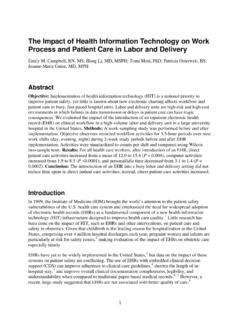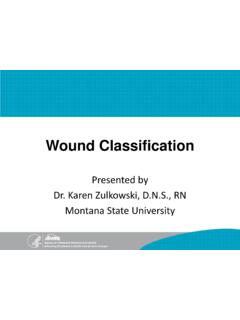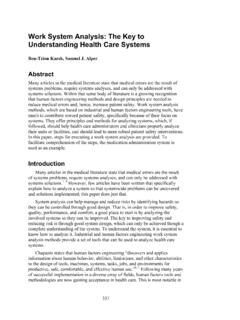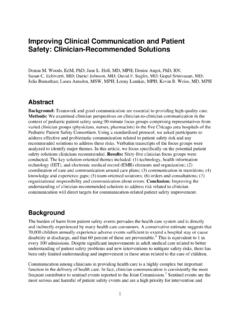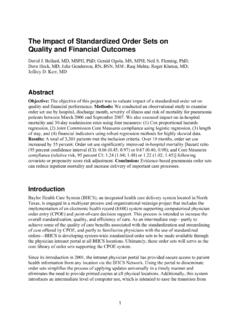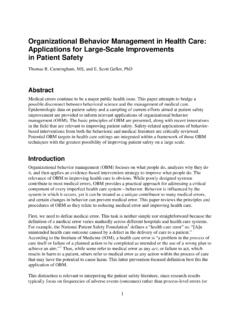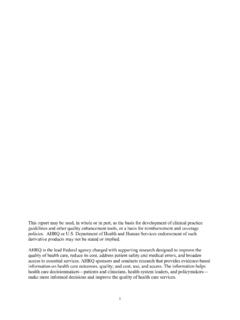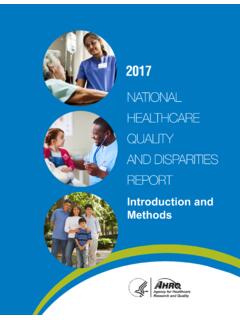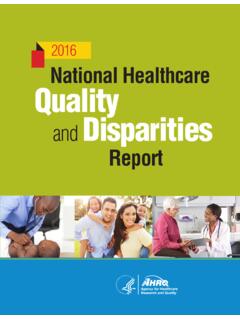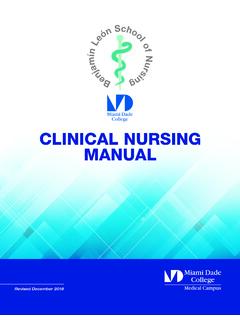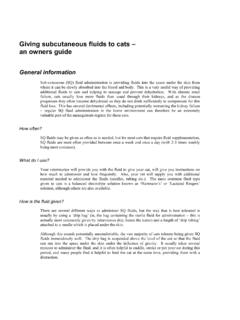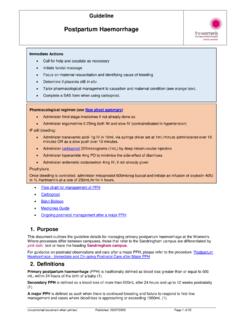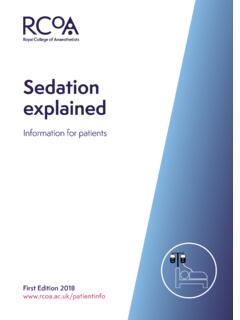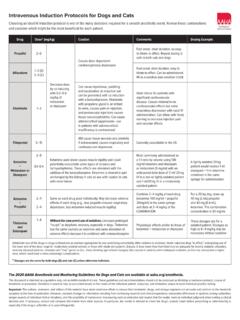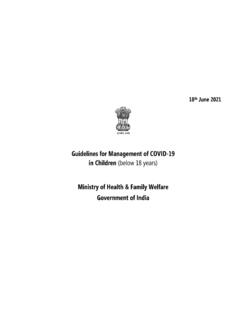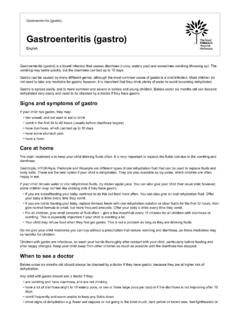Transcription of AHRQ Safety Program for Improving Antibiotic Use
1 AHRQ Safety Program for Improving Antibiotic Use 1 AHRQ Pub. No. 17(20)-0028-EF November 2019 Best Practices in the Diagnosis and Treatment of Diverticulitis and Biliary Tract Infections Acute Care Slide Title and Commentary Slide Number and Slide Best Practices in the Diagnosis and Treatment of Diverticulitis and Biliary Tract Infections Acute Care SAY: This presentation will address two common intra-abdominal infections: diverticulitis and biliary tract infections. Slide 1 Objectives SAY: The objectives for this presentation are to: Describe the approach to the diagnosis of diverticulitis and biliary tract infections Identify options for empiric Antibiotic therapy for diverticulitis and biliary tract infections Discuss the importance of source control in the management of intra-abdominal infections Identify options for Antibiotic therapy for diverticulitis and biliary tract infections after additional clinical data are known Describe the optimal duration of therapy for diverticulitis and biliary tract infections Slide 2 Acute Care 2 2 AHRQ Safety Program for Improving Antibiotic Use Acute Care Diverticulitis and Biliary Tract Slide Title and Commentary Slide Number and Slide Diverticulitis SAY: We will start by discussing diverticulitis.
2 Slide 3 The Four Moments of Antibiotic Decision making SAY: We will review diverticulitis using the Four Moments of Antibiotic Decision making . 1. Does my patient have an infection that requires antibiotics? 2. Have I ordered appropriate cultures before starting antibiotics? What empiric therapy should I initiate? 3. A day or more has passed. Can I stop antibiotics? Can I narrow therapy or change from intravenous to oral therapy? 4. What duration of Antibiotic therapy is needed for my patient's diagnosis? Slide 4 3 3 AHRQ Safety Program for Improving Antibiotic Use Acute Care Diverticulitis and Biliary Tract Slide Title and Commentary Slide Number and Slide The Four Moments of Antibiotic Decision making SAY: Moment 1 is: Does my patient have an infection that requires antibiotics? Slide 5 4 4 AHRQ Safety Program for Improving Antibiotic Use Acute Care Diverticulitis and Biliary Tract Slide Title and Commentary Slide Number and Slide Moment 1: Diagnosis of Diverticulitis SAY: Diverticulitis is defined as inflammation of one or more diverticula.
3 Disease presentation ranges from mild inflammation to colonic perforation and sepsis. Only about 5 percent of patients with diverticulosis will develop diverticulitis; remember that the presence of just diverticulosis on abdominal imaging does not mean that infection or inflammation is present. Most people with diverticulitis are older than 60, although recent trends suggest that younger people are also developing the disease. The vast majority of patients presenting with diverticulitis will have abdominal pain, usually in the left lower quadrant as the sigmoid colon is the most common site of both diverticulosis and diverticulitis. Most patients will also report at least low-grade fever. In addition to abdominal pain on palpation, patients may have a palpable mass indicating inflammation or abscess; the latter occurs in about 15 20 percent of cases. Most patients will have associated leukocytosis. Many patients will have a history of constipation or prior episodes of similar pain.
4 The imaging method of choice for diverticulitis is CT, which can also help with categorizing the extent of disease by detecting associated abscess, phlegmon, perforation and microperforation, and fistula. Slide 6 5 5 AHRQ Safety Program for Improving Antibiotic Use Acute Care Diverticulitis and Biliary Tract Slide Title and Commentary Slide Number and Slide The Four Moments of Antibiotic Decision making SAY: Moment 2 is: Have I ordered appropriate cultures before starting antibiotics? What empiric therapy should I initiate? Slide 7 6 6 AHRQ Safety Program for Improving Antibiotic Use Acute Care Diverticulitis and Biliary Tract Moment 2: Microbiologic Diagnosis and Empiric Therapy SAY: making a microbiological diagnosis in diverticulitis is challenging unless the patient has an abscess that is drained and sent for culture. Blood cultures are of low yield and generally should not be obtained unless the patient has concomitant signs and symptoms of sepsis.
5 The most common organisms that cause diverticulitis are E. coli, K. pneumoniae, and B. fragilis; thus, empiric therapy should at a minimum cover these organisms. Empiric therapy should also be guided by the severity of illness of the patient and the extent of disease. For patients with acute uncomplicated diverticulitis, as of April 2019, the American Gastroenterological Association suggests that antibiotics should be used selectively, rather than routinely; this recommendation will be reviewed further on the next slide. If antibiotics are given for uncomplicated diverticulitis, consider amoxicillin/clavulanic acid or an oral cephalosporin plus metronidazole if the patient can take oral therapy. If intravenous therapy is needed cefazolin, cefuroxime, or ceftriaxone, all plus metronidazole or ampicillin/sulbactam alone can be used. For patients with complicated diverticulitis, that is diverticulitis associated with an abscess, fistula, obstruction or perforation, IV therapy with cefazolin, cefuroxime, or ceftriaxone, all plus metronidazole or ampicillin/sulbactam alone can be used.
6 Local data on E. coli susceptibilities to these agents should be evaluated when making treatment recommendations. This is a particular concern when using ampicillin/sulbactam for which significant decreases in E. coli susceptibility have been noted in many parts of the country. Finally, some institutions may recommend ertapenem, although as of April 2019 it is more expensive. For patients with complicated diverticulitis associated with sepsis, consider broader coverage for Enterobacteriaceae and Pseudomonaswith piperacillin/tazobactam or cefepime plusmetronidazole. In general, S. aureus is an uncommon cause of diverticulitis and empiric coverage directed at MRSA Slide 8 7 7 AHRQ Safety Program for Improving Antibiotic Use Acute Care Diverticulitis and Biliary Tract Slide Title and Commentary Slide Number and Slide with vancomycin is not needed in the majority of cases. Although recommended in the 2010 Infectious Diseases Society of America clinical guidelines on intra-abdominal infections, the subject matter experts who created this resource believe that empiric coverage for Enterococcus species is not needed in all cases as it is an organism of low virulence, and lack of empiric coverage has not been shown to impact patient outcomes.
7 If there are current or prior cultures growing Enterococcus spp. or a strong clinical concern that a patient has a high risk of severe infection from Enterococcus spp., then an agent directed against them should be considered, for example piperacillin/tazobactam. Further, empiric coverage for Candida species is not needed in most cases. If there are current or prior biliary cultures growing Candida spp. or a strong clinical concern that a patient has a high risk of severe infection from Candida spp., then an agent directed against them should be considered. For patients with severe penicillin allergies, consider fluoroquinolone or aztreonam-based regimens, making sure to include anaerobic coverage unless moxifloxacin is used. Moxifloxacin has anaerobic activity; thus, addition of metronidazole is not needed when using this agent. Vancomycin should be added to ciprofloxacin and aztreonam in patients presenting with sepsis as these agents do not have Gram-positive activity to cover streptococci or enterococci.
8 Patients who are hospitalized should also be managed with IV fluids and pain control. 8 8 AHRQ Safety Program for Improving Antibiotic Use Acute Care Diverticulitis and Biliary Tract Slide Title and Commentary Slide Number and Slide Moment 2: Are Antibiotics Needed for Uncomplicated Diverticulitis? SAY: Several randomized controlled trials and cohort studies have suggested that antibiotics may not be needed for treatment of patients with uncomplicated diverticulitis. The first of these, published in 2012, randomized 623 patients to receive either no Antibiotic therapy or standard of care Antibiotic therapy; these patients received at least 7 days of therapy with the regimens chosen by the care team. These included a cephalosporin plus metronidazole, a carbapenem or piperacillin/tazobactam followed by oral therapy with ciprofloxacin. Patients had CT-confirmed diverticulitis without complicating features and were admitted to the hospital.
9 Baseline characteristics were similar between the groups. 97 percent of patients had abdominal pain, 90 percent had fever, and the mean WBC was The three curves show the time course of decrease in abdominal pain by patient report, temperature, and abdominal tenderness from baseline through day 5 of hospital admission. Note that patients who did not receive antibiotics (in pink) had almost identical clinical courses as patients who did receive antibiotics (in blue). Patients were followed for 12 months. Complications were rare in the two groups with 2 percent of patients in the group that did not receive antibiotics and 1 percent of patient in the group that received antibiotics developing subsequent perforation or abscess. In practice, when considering not prescribing antibiotics, it is important to select patients who are stable without evidence of sepsis who clearly have uncomplicated disease by CT. Some have argued that most patients who meet these criteria may not be admitted to the hospital in the first place, although as long as the patient has a followup plan, it would be reasonable to also use this strategy in patients seen in clinic or the emergency department.
10 Slide 9 9 9 AHRQ Safety Program for Improving Antibiotic Use Acute Care Diverticulitis and Biliary Tract Slide Title and Commentary Slide Number and Slide Moment 2: When To Call the Surgeon SAY: Diverticulitis is an illness managed by many medicine and surgery providers. For patients admitted to medicine services, it is important to recognize when surgical consultation during the admission is indicated. Specific examples include the presence of perforation, peritonitis, obstruction, and/or failure of medical therapy. For patients with abscesses, management depends on the size of the abscess. Attempts should be made to percutaneously drain abscesses, particularly those 5 cm. Smaller abscesses (those that are 3 4 cm) may be harder to reach. If they cannot be drained, some small abscesses may respond to medical therapy alone. If the abscess is large and cannot be drained, surgical intervention is generally required.

